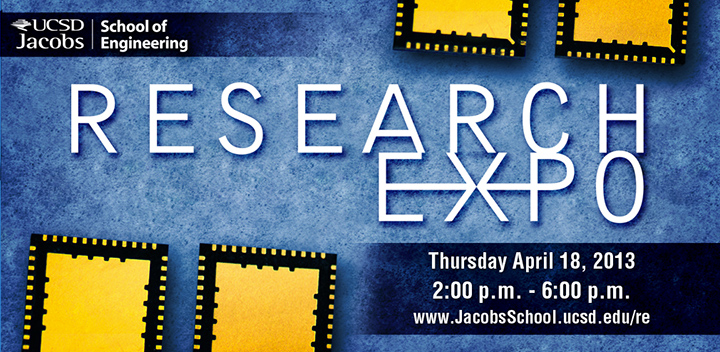
Want to Connect with the Future? Attend Research Expo at UC San Diego’s Jacobs School of Engineering
By:
- Daniel Kane
Published Date
By:
- Daniel Kane
Share This:
Article Content
Advances in tattoo sensors for health monitoring, on-chip optical networking, low-cost cancer diagnostics, video games designed to teach computer programming, new materials for protecting soldiers from blasts, and energy-efficient high-wire robots. These are just a few of the 200+ projects from Jacobs School of Engineering graduate students that will be on display at Research Expo on April 18 at the University of California, San Diego.

“Solving the world’s most pressing and complex challenges – in the realms of health, energy, information technology and other disciplines – requires research teams with a broad range of expertise working together. Research Expo is a showcase of the collaborations occurring every day on campus,” said UC San Diego Chancellor Pradeep K. Khosla.
Research Expo is April 18th from 2:00‒6:00 p.m. at the Price Center at UC San Diego. Register today.
“Research Expo is a great opportunity to get an inside look at the world-class research happening at the Jacobs School of Engineering, which is fueled by $164 million in research funding,” said Juan C. Lasheras, Interim Dean of the UC San Diego Jacobs School of Engineering. “At the poster session, you also get the chance to meet more than 200 of the graduate students who are engaged in this cutting-edge research.”
Lightning Talks at Research Expo
Research Expo includes ten-minute “lightning talks” from new faculty hires from all six engineering departments.
2:30 p.m.
Olivia Graeve, Mechanical & Aerospace Engineering
“How to Control the Shape of Matter (and Other Curiosities of Nature)”
2:50 p.m.
Drew Hall, Electrical & Computer Engineering
“Point-of-Care Medical Diagnostics”
3:10 p.m.
Christian Metallo, Bioengineering
“Tracing Metabolic Pathways to Understand and Treat Cancer”
3:30 p.m.
Andrea Tao, NanoEngineering
“Using ‘Nano’ To Rethink the Way We Design Solid-State Materials”
3:50 p.m.
Gilberto Mosqueda, Structural Engineering
“Large-scale Testing of Seismically Isolated Buildings”
4:10 p.m.
Shachar Lovett, Computer Science and Engineering
"Can Computation Be Made Local?"
Research Expo 2013 at a Glance
Poster Session: 2:00‒4:30 p.m.
Faculty Talks: 2:30‒4:30 p.m.
Networking Reception: 4:30‒6:00 p.m.
Industry Application Areas
This year, for the first time, the 200+ engineering graduate student posters are tagged on the Research Expo website by industry application area. For example, the “life sciences / medical devices & instruments” filter returns 49 posters from all six of the Jacobs School’s academic departments, as well as posters from graduate students with faculty advisors from the Division of Biological Sciences, the School of Medicine and the Skaggs School of Pharmacy and Pharmaceutical Sciences, all at UC San Diego.
“I’m astonished every year at how advanced the research is,” said UC San Diego alumnus William Proffer ('76, '78 M.S Applied Mechanics), a long-time Research Expo judge. Proffer is Assistant Vice President for Technology and Chief Systems Engineer for Science Applications International (SAIC) in La Jolla, Calif.
“For practicing scientists and engineers, Research Expo offers a refreshing view of what is current,” Proffer said.
The Jacobs School of Engineering thanks its generous Research Expo sponsors: Qualcomm, ViaSat and SAIC. Research Expo is a program of the Jacobs School’s Corporate Affiliates Program.
Research Expo Posters
Titles and industry application areas for all posters are posted on the Research Expo website. Pre-event access to full abstracts is reserved for Research Expo registrants. Register today.
Nanofoams for Better Blast Protection
Structural engineers are developing nanofoams that could be used to make better body armor; prevent traumatic brain injury and blast-related lung injuries in soldiers; and protect buildings from impacts and blasts. It’s the first time researchers are investigating the use of nanofoams for structural protection. Learn more.
Tattoos to Measure Stamina
By integrating complex electrochemical sensors with simple, fairground tattoos, nanoengineers have created a highly sensitive, wearable biosensor that monitors electrolyte and metabolite levels in sweat to assess the metabolic health of a patient, and in particular, their stamina. The temporary electrochemical tattoo relies on a carbon fiber backbone so that it bends with the skin during normal activity without loss of functionality as well as a conductive polymer that is sensitive to pH-levels in sweat. Learn more.
New Optical Waveguide
Information systems now rely primarily on fiber optic networks to connect and share data around the world using photons instead of electrons, but the underlying computer technology is still based on electronic chips. Researchers are hard at work developing on-chip optical networking devices such as optical waveguides, switches, and amplifiers. Electrical engineering graduate student Andrew Grieco is developing a new type of optical waveguide that promises to improve efficiency and reduce power consumption. Learn more.
Code Magic Spells. Learn Java.
Computer scientists have developed an immersive, first-person player video game designed to teach students elementary-age and above how to program in Java, one of the most common programming languages in use today. The researchers tested the game on a group of 40 girls, ages 10 to 12, who had never been exposed to programming before. They found that within just one hour of play, the girls had mastered some of Java’s basic components and were able to use the language to create new ways of playing with the game. The UC San Diego computer scientists plan to release the game for free and make it available to any educational institution that requests it. Researchers are currently conducting further case studies in local San Diego elementary schools. Read the press release and watch the video.
Share This:
You May Also Like
Stay in the Know
Keep up with all the latest from UC San Diego. Subscribe to the newsletter today.


